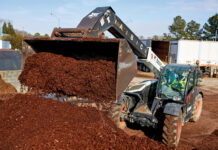
Hey lawn and landscape pros! As you gather all that lawn debris, have you thought of putting your design and contracting skills to use building a hotel—a bug hotel, that is? Or what about renovating a neglected one already on a client site? A Mar-A-LOG-o for beetles? A Hill-ton for bees? A Best Nestern for bird nesting materials? The Wildlife Habitat Council (WHC) in Bethesda, MD wants to see your bug accommodations! Enter the WHC’s ‘Best of’ Insect Hotel Challenge as they search for the best ones! It could be a great activity to do with your kids. Categories include:

- Best Large Size Hotel
- Best Small to Mid Size Hotel
- Best Use of Found Materials
- Best Renovation of an Existing Hotel
Insect hotels must be built (not bought) and must either be new builds or renovations of existing hotels. For any questions about the challenge or entry rules, please contact Melissa Scheiber. The deadline for entries is September 1, 2023. Winners will be announced in October.
As those in the Green Industry know, insects play a key role in healthy ecosystems — they pollinate plants, improve soil health and serve as a crucial part of the food chain. Despite their importance, insect populations have seen a decline in recent years. A bug hotel is an easy and inexpensive way to support insects in a habitat near you. Not only do these structures provide shelter for pollinators and other insects, but building them also serves as a fun activity that raises awareness about the importance of insects.
Know Your Ecological Region
Learn the basics of constructing your own bug hotel and tips on using an insect hotel in an on-demand webinar here or download the insect hotel resource guide here. The resource guide includes links to step-by-step insect hotel building instructions, as well as a link to Pollinator Partnership Planting Guides. At the Pollinator Partnership website, simply type in your zip code to determine your ecological region. (Note: ecological regions are different than USDA Plant Hardiness Zones.) There are 36 different eco regions within the U.S. ranging from Adirondack to Southern Rocky Mountain Steppe. (For instance, I determined my zone in central NJ along the Raritan Bay is the Eastern Broadleaf Forest-Oceanic Province.)
After determining your ecological region, click on your regional guide for a free download. Inside each guide are 24 pages of native planting information in PDF format.
For more on pollinators, see Why Mighty Oaks Should Be On Your Planting List, written for Turf magazine by famed ecologist Douglas Tallamy.











![[VIDEO] Dickies®: Discover Workwear That’s Anything But Uniform](https://turfmagazine.com/wp-content/uploads/2023/06/1647663814-4b1a2a7742790a9b1e97a3b963477850192e1d6a9dfba9b07214a77bae25d6e3-d-218x150.jpg)





























![[VIDEO] Dickies®: Discover Workwear That’s Anything But Uniform](https://turfmagazine.com/wp-content/uploads/2023/06/1647663814-4b1a2a7742790a9b1e97a3b963477850192e1d6a9dfba9b07214a77bae25d6e3-d-324x160.jpg)